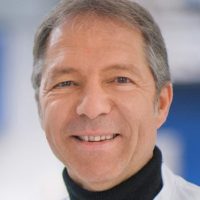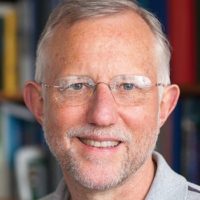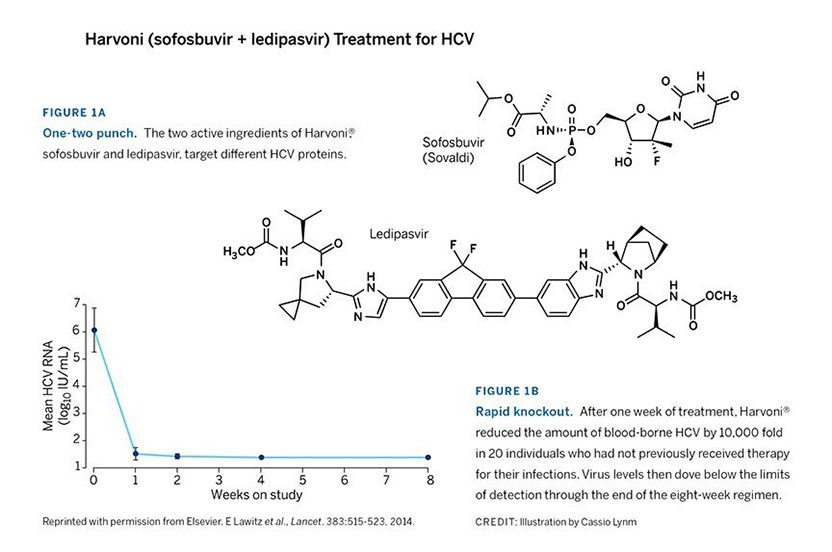
Ralf F.W. Bartenschlager
Heidelberg University

Charles M. Rice
Rockefeller University

Michael J. Sofia
Arbutus Biopharma
The 2016 Lasker~DeBakey Clinical Medical Research Award honors three scientists who developed a system to study the replication of the virus that causes hepatitis C and used this system to revolutionize the treatment of this chronic, often lethal disease. For more than a decade, Ralf F. W. Bartenschlager (University of Heidelberg) and Charles M. Rice (Rockefeller University) attempted to coax the hepatitis C virus (HCV) to multiply inside lab-grown host cells. They conquered one challenge after another and eventually triumphed. With similar perseverance and imagination, Michael J. Sofia (formerly at Pharmasset; now at Arbutus Biopharma) then exploited this system to test and invent candidate drugs, whose novel design allowed targeting of the liver, where HCV resides, and creation of a medicine with unprecedented potency and safety.
Award presentation by Harold Varmus
Most of us don’t spend much time thinking about our livers. Unlike our pumping hearts and our reasoning brains, the liver is normally a silent, though essential, partner. Now it is quietly working on our lunch, keeping us in metabolic balance. But when damaged by alcohol, infiltrated by metastatic cancer, or felled by a viral infection, it can no longer be ignored.
Hepatitis C virus (or HCV) is one of the things that can bring the liver to our attention. The virus is growing persistently in the livers of an estimated 170 million people worldwide and over 3 million in the US. With time, HCV can destroy the liver’s essential functions, since an infection is often a prelude to cirrhosis or liver cancer.
Acceptance remarks
Acceptance remarks, 2016 Lasker Awards Ceremony
Passion, most often requiring an adequate trigger, supporting people, and luck are the most important ingredients for a scientific career. I had the fortune to have all of them.
When I grew up with my grandparents in an industrial suburb of Mannheim, my main interest was playing soccer and I had no clue what my future profession would be. This changed in high school where I met an excellent teacher who raised my interest in biology. Recognizing my new inspiration, my grandparents bought me a small microscope as a Christmas present that I used in my spare time to examine all sorts of biological samples, although often with disappointing results because of its poor resolution.
During those days I decided to study biology even though people were telling me at that time, the late 1970s, that the demand for biologists in Germany is very low; one biologist per year, so why should I be this person? Nevertheless, my passion for this topic was stronger than any concerns about my professional future, so after a 4-year interim time during which I was trained and practiced as a police officer, I began to study biology at Heidelberg University.
During my time as student, I developed a growing interest in molecular biology, which in Germany was at its infancy. Fortunately, there were several professors in Heidelberg, who did postdocs in the US and after their return to Germany started to build up labs that used most modern molecular biology methodologies. One of these labs was headed by Heinz Schaller. Heinz worked on hepatitis B virus, a topic that I found fascinating, but getting access to his lab was not an easy task. resistance. Fortunately, he accepted me as lab practical student to establish a method for cloning duck hepatitis B virus mutants. I assume I did my job right, because Heinz took me under his wing and really taught me the secrets of scientific working. I left his lab in 1991, and in 2002 I got the chance to return back to Heidelberg to set up a new research department made possible by a foundation set up by Heinz and his wife Chica.
Success in science also requires luck. My biggest luck was the privilege to host numerous incredibly talented students and postdocs in my lab. While all have contributed tremendously, there was one person who influenced my career most: Volker Lohmann, my very first PhD student. Recruiting Volker was one of the biggest strokes of luck in my scientific life as he was not only the key person to set up the first HCV cell culture system, but also an exceptional mind creating true team spirit and synergy within the research team.
Being a scientist is not just a job, it is a vocation—the pursuit of knowledge and the elation of discovery are the twin triggers of passion in science. But this vocation also brings long working hours, hectic days, and frequent travel. Without the continuous encouragement of my wife Judith, and without the enrichment that my children Marie, Nora, and Lorenz have provided to my life, I would not be here today. Thank you.
Passion, most often requiring an adequate trigger, supporting people, and luck are the most important ingredients for a scientific career. I had the fortune to have all of them.
When I grew up with my grandparents in an industrial suburb of Mannheim, my main interest was playing soccer and I had no clue what my future profession would be. This changed in high school where I met an excellent teacher who raised my interest in biology. Recognizing my new inspiration, my grandparents bought me a small microscope as a Christmas present that I used in my spare time to examine all sorts of biological samples, although often with disappointing results because of its poor resolution.
During those days I decided to study biology even though people were telling me at that time, the late 1970s, that the demand for biologists in Germany is very low; one biologist per year, so why should I be this person? Nevertheless, my passion for this topic was stronger than any concerns about my professional future, so after a 4-year interim time during which I was trained and practiced as a police officer, I began to study biology at Heidelberg University.
During my time as student, I developed a growing interest in molecular biology, which in Germany was at its infancy. Fortunately, there were several professors in Heidelberg, who did postdocs in the US and after their return to Germany started to build up labs that used most modern molecular biology methodologies. One of these labs was headed by Heinz Schaller. Heinz worked on hepatitis B virus, a topic that I found fascinating, but getting access to his lab was not an easy task. resistance. Fortunately, he accepted me as lab practical student to establish a method for cloning duck hepatitis B virus mutants. I assume I did my job right, because Heinz took me under his wing and really taught me the secrets of scientific working. I left his lab in 1991, and in 2002 I got the chance to return back to Heidelberg to set up a new research department made possible by a foundation set up by Heinz and his wife Chica.
Success in science also requires luck. My biggest luck was the privilege to host numerous incredibly talented students and postdocs in my lab. While all have contributed tremendously, there was one person who influenced my career most: Volker Lohmann, my very first PhD student. Recruiting Volker was one of the biggest strokes of luck in my scientific life as he was not only the key person to set up the first HCV cell culture system, but also an exceptional mind creating true team spirit and synergy within the research team.
Being a scientist is not just a job, it is a vocation—the pursuit of knowledge and the elation of discovery are the twin triggers of passion in science. But this vocation also brings long working hours, hectic days, and frequent travel. Without the continuous encouragement of my wife Judith, and without the enrichment that my children Marie, Nora, and Lorenz have provided to my life, I would not be here today. Thank you.
Acceptance remarks, 2016 Lasker Awards Ceremony
As I look back over nearly 40 years of studying viruses, I never imagined that I would be standing here today. Viruses are great teachers, and unraveling their secrets continues to reveal new wonders about biology and evolution.
My interest in flaviviruses was kindled as a postdoc and continued when I began my laboratory at Washington University. We studied the prototype family member, yellow fever virus, a nasty mosquito-borne virus made famous by Walter Reed. It became the poster child for human vaccination based on a live-attenuated variant derived in 1937 by Nobel Prize recipient Max Theiler.
In the midst of exploring the details of yellow fever replication, hepatitis C appeared on the scene in 1989 as the major cause of non-A, non-B hepatitis. Given its similarity to yellow fever and other flaviviruses, we began a small effort on this new human virus associated with progressive liver disease and cancer. We weren’t specifically searching for a cure. We were just trying to better understand the virus. Together with Ralf and others in the field, we made progress but struggled to get the virus to grow in the lab. With each apparent breakthrough, we were met with new roadblocks to overcome. In both patients and in the laboratory hepatitis C was a persistent troublemaker.
I must admit that most of us in the field became increasingly frustrated by the difficulty in working with this virus and our slow progress at a time when new therapies were sorely needed by patients. But when the breakthroughs finally came, the tools were in hand to validate potential antiviral targets and screen for inhibitory compounds. A flood of new drugs rapidly ensued. Regimens with amazing efficacy and very few side effects are now approved and in the clinic, although we still face many public health challenges for global implementation.
It is wonderful to have played a small role in this biomedical success story. About 20 years ago, I was contacted by a family whose little girl had hepatitis C. For years, they agonized over whether to treat or not. They decided to wait for the new drugs. Last week, this message arrived: “Hi Charlie. I just read that you will be receiving a Lasker Award for your work in helping cure Hep C. Congratulations!!! We are so excited for you and remain grateful that our daughter is cured and leading a happy normal life. In fact, happily married with an eighteen month old, our daughter is now expecting her second child.” For a basic scientist, no reward is more unexpected or better than this.
In closing, I remember my mother asking “why do you work on yellow fever—we have a vaccine for that, don’t we?” She was right of course, but we were curious about that virus and forged ahead anyway. This experience with yellow fever paved the way for our work on hepatitis C and to me reinforces the importance of keeping a diverse research portfolio—you never know what’s coming next! It also underscores the importance of supporting and promoting fundamental curiosity-driven research as the driver of great medical advances.
Acceptance remarks, 2016 Lasker Awards Ceremony
As I look back over nearly 40 years of studying viruses, I never imagined that I would be standing here today. Viruses are great teachers, and unraveling their secrets continues to reveal new wonders about biology and evolution.
My interest in flaviviruses was kindled as a postdoc and continued when I began my laboratory at Washington University. We studied the prototype family member, yellow fever virus, a nasty mosquito-borne virus made famous by Walter Reed. It became the poster child for human vaccination based on a live-attenuated variant derived in 1937 by Nobel Prize recipient Max Theiler.
In the midst of exploring the details of yellow fever replication, hepatitis C appeared on the scene in 1989 as the major cause of non-A, non-B hepatitis. Given its similarity to yellow fever and other flaviviruses, we began a small effort on this new human virus associated with progressive liver disease and cancer. We weren’t specifically searching for a cure. We were just trying to better understand the virus. Together with Ralf and others in the field, we made progress but struggled to get the virus to grow in the lab. With each apparent breakthrough, we were met with new roadblocks to overcome. In both patients and in the laboratory hepatitis C was a persistent troublemaker.
I must admit that most of us in the field became increasingly frustrated by the difficulty in working with this virus and our slow progress at a time when new therapies were sorely needed by patients. But when the breakthroughs finally came, the tools were in hand to validate potential antiviral targets and screen for inhibitory compounds. A flood of new drugs rapidly ensued. Regimens with amazing efficacy and very few side effects are now approved and in the clinic, although we still face many public health challenges for global implementation.
It is wonderful to have played a small role in this biomedical success story. About 20 years ago, I was contacted by a family whose little girl had hepatitis C. For years, they agonized over whether to treat or not. They decided to wait for the new drugs. Last week, this message arrived: “Hi Charlie. I just read that you will be receiving a Lasker Award for your work in helping cure Hep C. Congratulations!!! We are so excited for you and remain grateful that our daughter is cured and leading a happy normal life. In fact, happily married with an eighteen month old, our daughter is now expecting her second child.” For a basic scientist, no reward is more unexpected or better than this.
In closing, I remember my mother asking “why do you work on yellow fever—we have a vaccine for that, don’t we?” She was right of course, but we were curious about that virus and forged ahead anyway. This experience with yellow fever paved the way for our work on hepatitis C and to me reinforces the importance of keeping a diverse research portfolio—you never know what’s coming next! It also underscores the importance of supporting and promoting fundamental curiosity-driven research as the driver of great medical advances.
The 2016 Clinical Award video
Video Credit: Flora Lichtman

